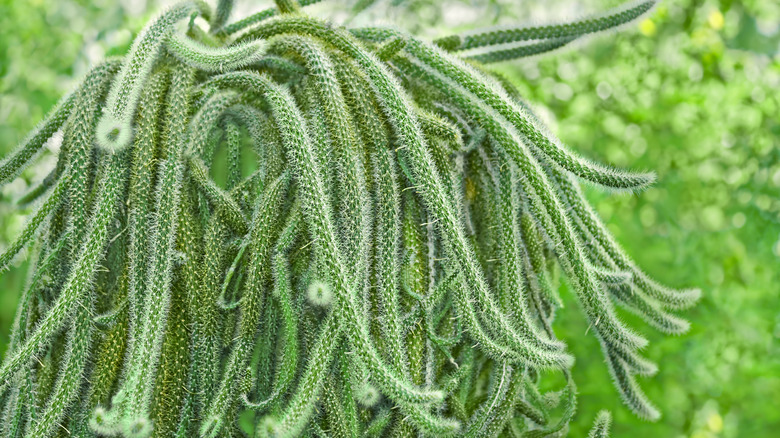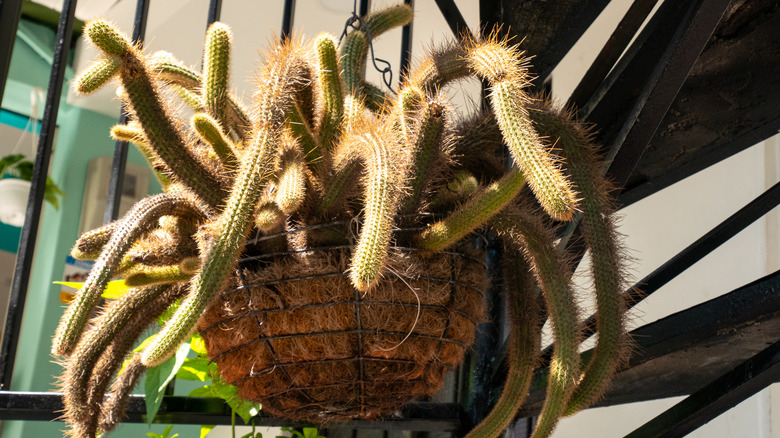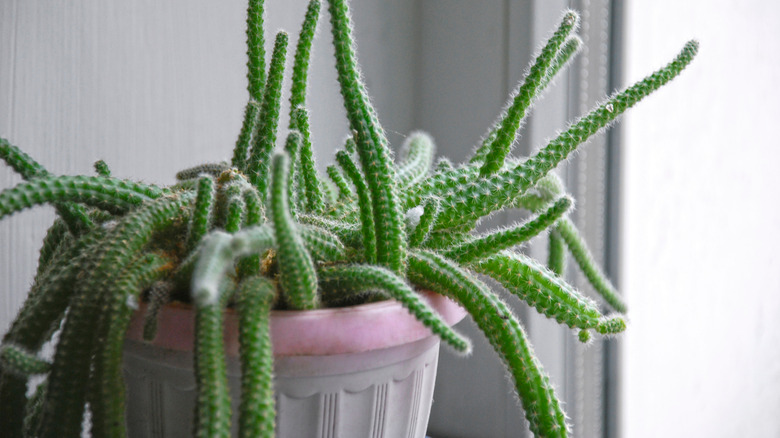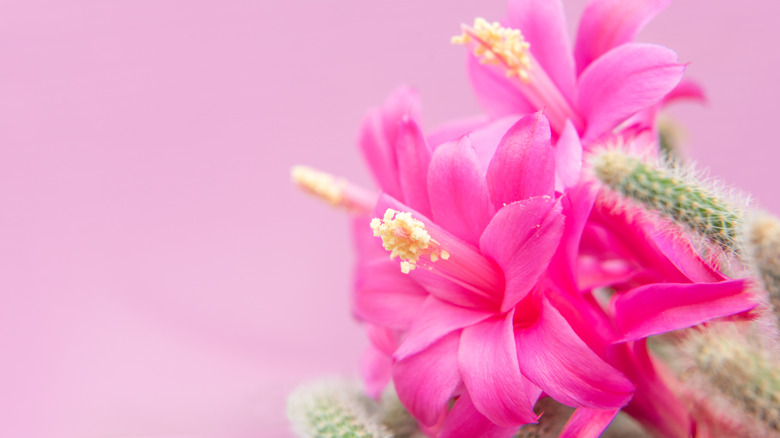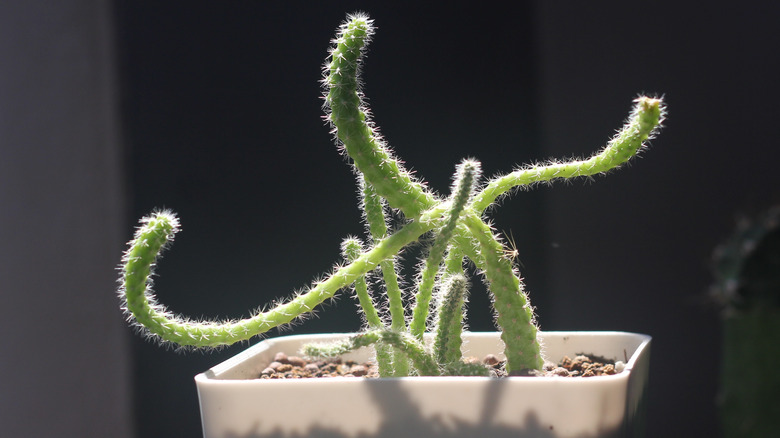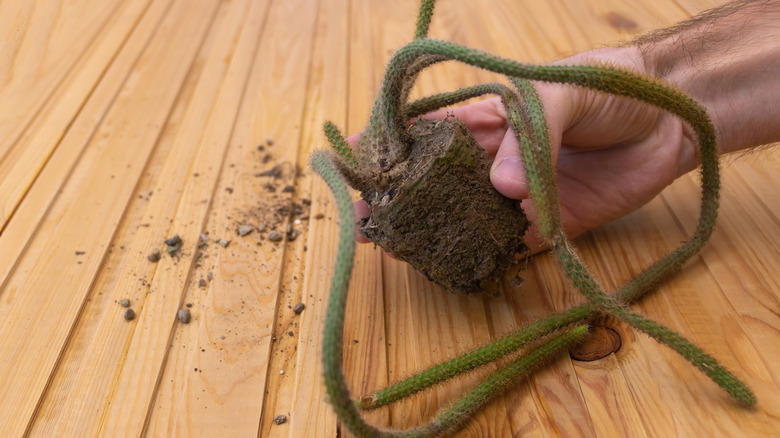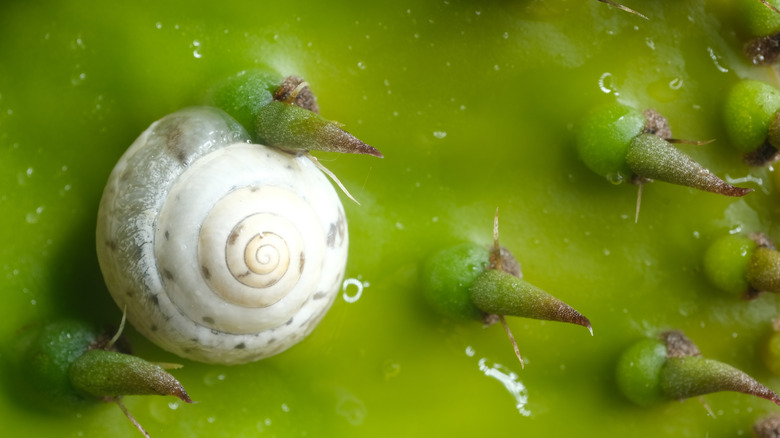How To Care For A Rat Tail Cactus
Aporocactus flagelliformis, commonly referred to as the rat tail cactus, is a unique plant that features long, rat tail-like stems. These stems can become 3 to 6 feet long, and they are covered with fine spikes. When well taken care of, the plant can also produce 3-inch long tubular flowers in a bright pinkish-red color, according to Gardening Know How. People love adding the rat tail cactus to their plant collection due to its interesting growth pattern and rewarding seasonal blooms.
The rat tail cactus is native to Mexico and Central America, as noted by Royal Botanical Gardens KEW, and it can be quite difficult to keep alive outdoors in any other region. It grows naturally on the ground in low, rocky soil or on trees and other tree-like structures. As long as you can provide this cactus with the conditions it needs, it will survive in your home for years.
How to use a rat tail cactus in garden
Rat tail cacti may be grown in USDA hardiness zones 10 through 12, as per World of Succulents, but be wary if you live in an extremely humid climate. Too much humidity can lead to rotted stems. Most gardeners grow their rat tail cactus in hanging planters to allow their stems to trail downward. This is a great option because it allows you to easily move the cactus indoors when temperatures outside become too chilly for proper growth. Additionally, growing this cactus in a hanging planter can also help keep pests from bothering the plant. Rat tail cacti are particularly threatened by snails, slugs, spider mites, and mealybugs.
Keep in mind that it is even rarer for a rat tail cactus to bloom when grown outdoors in a garden. You may need to wait years before this cactus produces even one small flower which will die as the season transitions to summer, as said by Houmse.
How to grow a rat tail cactus
To grow a rat tail cactus, you'll need a well-draining potting mixture that uses loam, sand, and perlite, according to Gardening Know How. You'll also need a self-draining pot and gloves to protect yourself from this plant's spines. There are two common ways of growing the rat tail cactus: You can either grow it from seeds or cuttings.
Growing rat tail cacti from cuttings is the easiest way to go about it. To start, cut off a length of stem from a healthy and mature rat tail cactus. Then, let the cutting get dry and callous for at least two weeks, as per Succulent Alley. Once dry, plant the stem in rich potting soil with the cut end facing down. After a few more weeks your cutting should produce roots. As long as you keep the individual stem in a sunny spot with some humidity, it should become a fast-growing rat tail cactus in no time at all.
How to care for a rat tail cactus
After planting your rat tail cactus in a pot, it shouldn't be too difficult to care for; these are extremely drought and neglect tolerant plants. Most of the problems you might find with this cactus involve pests and overwatering. As long as you keep it in a warm, dry place and give it regular but infrequent watering, your cactus could stay living for a very long time.
Specifically, rat tail cacti need bright, unfiltered light. In the wild, this cactus prospers in the desert, as stated by The Spruce. Therefore, you should try to mimic the same conditions. Place it in a sunny window where it will receive as much direct sunlight as possible. Putting it outside during the hot summer months will help it get the sunshine it needs.
You can stick to a simple watering schedule with this plant. Plan to water it thoroughly during the growing season each time its soil dries out. You can check this by pushing your finger into the soil to see if it is still wet. Additionally, while your rat tail cactus is growing, you may feed it with diluted liquid fertilizer twice per month to encourage more growth. As winter approaches, you should cut back on this plant's watering, only hydrating it with small drinks of water as the soil dries fully. Do not fertilize the rat tail cactus during the winter or fall.
Is a rat tail cactus toxic?
The rat tail cactus is not on the ASPCA's list of toxic plants, as per About Succulents. However, that does not mean that the plant isn't dangerous to pets such as cats, dogs, and horses. Most plants in the Cactaceae family are listed as non-toxic to pets and humans, but it's better to be cautious when a specific species' toxicity is unknown. You should not take chances with a plant like this that could affect your pet's health and wellbeing.
Due to the rat tail cactus' many sharp spines, you should keep it out of reach of small children and pets. Grabbing or chewing on the stem of this cactus can lead to cuts and gashes that may need medical attention, especially if they become infected. Consider placing your rat tail cactus on a high shelf next to a south or west-facing window, or in the same area using a hanging planter.
How to repot a rat tail cactus
Repotting a rat tail cactus is easier than one might assume. As long as you have a pair of thick gloves, a pot, and some fresh, well-draining potting soil, you're ready to start. The Spruce recommends repotting the rat tail cactus once per year after the growing season. The pot you choose may be the same size as the last or slightly bigger. The repotting process is only needed to refresh the soil which is quickly depleted of its nutrients by the rat tail cactus. If yours has been thriving at a mature age for a while, it's unlikely that you will need a larger container.
When beginning the repotting process be sure to put on your gloves first. Then, you can gently remove the cactus from its pot, tipping it upside down while you hold onto the plant's base. If you are having trouble dislodging it, run a flat tool along where the soil meets the container. Once out of its pot, evict the excess dirt from the roots by breaking it up with your fingers or a gardening fork. Next, prepare the new pot by filling it partly full with new soil before placing the cactus into it. Add more soil on top of your rat tail's roots and pack it around the plant's base. If you took these steps in the fall, after the growing season, wait to water your newly repotted rat tail cactus until the soil is dry.
Pests and problems of the rat tail cactus
Snails, slugs, mealybugs, and spider mites are the biggest threats to the rat tail cactus, according to Houmse. Infestations of any of them can lead to a very unhappy plant. Luckily, they can be easily treated once you identify these pests.
Snails and slugs are the easiest to spot. Surprisingly, they will climb all over your rat tail cactus seemingly undisturbed by the sharp spines. Once they take a bite out of your cactus, it will be there for a very long time as an annoying eyesore. You can deter and deal with slugs and snails by setting traps or sprinkling coffee grounds, garlic, or wood ash near your plant.
Mealybugs and spider mites are harder to find, but easier to deal with. If you notice small white webs or tiny white or brown spots on the plant's stems, you may have an infestation on your hands. Banishing mealybugs and spider mites can be done in a couple of ways. You can either find an insecticidal soap made for cacti or spray neem oil onto your cactus to kill these pests.
